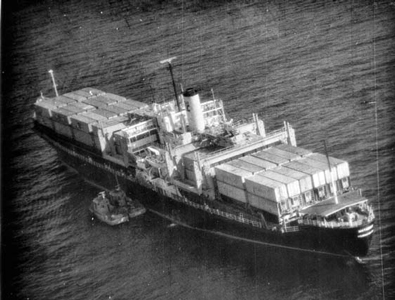
On this date in 1975, the American freighter Mayagüez, with its 39-man crew, was captured by Khmer Rouge forces in the Kingdom of Cambodia. Not two weeks before, the U.S. had been routed by the Vietnamese; and less than a month before, the Khmer Rouge had taken control of the capital Phnom Penh, ousting the U.S.-backed Khmer Republic.
The Mayagüez incident, taking place over four days, May 12-15, revealed how sensitive the U.S. felt about its world standing and credibility after its crushing defeat in Vietnam. It was not prepared to allow a purported act of sea piracy — though this claim had no foundation in maritime law — to pass without a robust response.
The crisis began on May 12, as the container ship, owned by Sea-Land Service, passed Poulo Wai island en route to Thailand, within 12 nautical miles of Cambodian territorial waters. The U.S. did not recognize 12 nautical miles territorial waters claims at that time, recognizing only 3 nautical miles, and characterized the location as international sea lanes on the high seas. U.S. military reports state that the seizure took place 6 nautical miles off the island, but the crew brought evidence in a later legal action that the ship had in fact sailed about two nautical miles off Poulo Wai and was not flying a flag.
Thus, the question of which side set off an international incident is highly debatable.
The Mayagüez was carrying 107 containers of routine cargo, 77 containers of government and military cargo, and 90 empty containers. The exact contents have never been disclosed, but the ship had loaded containers from the U.S. Embassy in Saigon nine days before the fall of Saigon.
The Cambodians imprisoned the American crew, pending an investigation of the ship and why it had sailed into Cambodian waters. Diplomatic approaches to China involving Secretary of State Henry Kissinger and George H. W. Bush, then head of the U.S. Liaison Office in Beijing, produced no results. Pres. Gerald Ford moved swiftly to the rescue, on May 14 ordering the bombing of the Cambodian port where the Khmer Rouge gunboats had come from and sending Marines to attack the island of Koh Tang, where the prisoners were presumed being held. Unknown to the Americans, none of the crew were on the island and it was heavily defended by over 100 Khmer Rouge. The Khmer Rouge defenses on the island were intended to counter the Vietnamese who, following the recapture of Saigon, moved quickly to take control of a number of islands contested between Vietnam and Cambodia.
But military action was probably unnecessary. The Cambodian government was already in the process of releasing the crew and the ship. Forty-one Americans died — most of them in an accidental explosion during the attack — and 50 were wounded. They are remembered as the last killed in what is considered “the last official battle of the Vietnam War.” Their names, as well as those of three U.S. Marines who were left behind on the island of Koh Tang after the battle and were subsequently executed by the Khmer Rouge, are the last names on the Vietnam Veterans Memorial.
A Khmer Rouge radio broadcast announced that the Mayagüez and its crew would be released. “We have no intention of detaining it permanently,” the communiqué read, “and we have no desire to stage provocations. We only wanted to know the reason for its coming and to warn it against violating our waters again. This is why our coast guard seized this ship.”
The crew were released in good health, after agreeing to a statement that they had not been mistreated, unknown to the U.S. Marines or the U.S. command of the operation before they attacked. When the Marines boarded and recaptured the ship — one of the few hostile ship-to-ship boardings by the U.S. Navy since the American Civil War — they found it empty.
Estimates of Khmer Rouge casualties were 13-25 killed on Koh Tang, with an unknown number killed on Swift Boats and on the Cambodian mainland.
Pres. Ford went on U.S. national television announcing the recovery of the Mayagüez and the rescue of its crew, but obscuring the fact that the crew had in fact been released by the Khmer Rouge.
Crew members brought admiralty law suits against Sea-Land Service, claiming that the Master was derelict in his duty by “recklessly venturing into known dangerous and hostile waters of foreign sovereignty (Cambodia),” inviting capture. In February 1979 a final settlement was reached, with a total of $388,000 to the crew members taking legal action.
Photo: Wikipedia Commons







